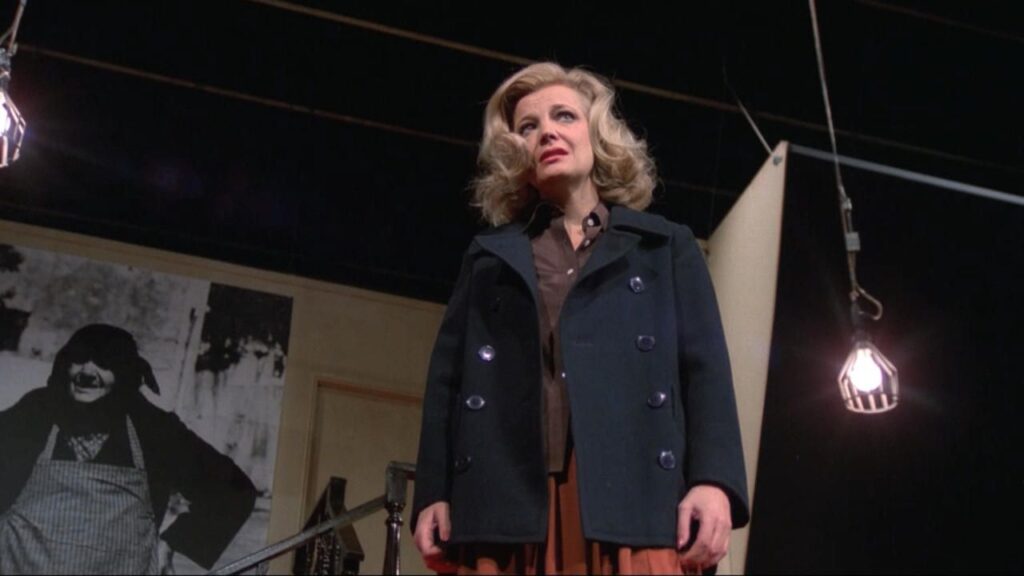
John Cassavetes’ film Opening Night (1977) is not surreal in the traditionally filmic sense, but in many ways comes closer to surrealism than most American films that claim to do so. Opening Night lacks any dream-like environment or set and does not present any superficially fantastic personas, however, fantastic personas do exist for Cassavetes within the careful character constructs of Opening Night. What becomes surreal in Cassavetes’ theater drama is the multitude of personalities each character possesses. This phenomenon does not appear wholly surreal because the occupation of these characters is that of actors. One can thus make the case that acting, as an occupation, is an entirely surreal exercise. In Opening Night Cassavetes must maneuver through his principals’ repertoire of personalities.
To do this, Cassavetes takes an unprecedented approach when he introduces the supernatural element of a ghost. The ghost appears only to the lead character Myrtle [Gena Rowlands]; a ghost of a fan who is struck dead by a car trying to reach Myrtle’s limousine after a performance. What Cassavetes has done is create a plane of consciousness that physically manifests itself within the film in crucial sequences in which Myrtle attempts to exorcise her ghost. She attacks a mirror in her hotel room with Manny [Ben Gazzara] as witness. The significance of Manny is that he does not share this vision, which cues the audience into the fact that Myrtle is being privileged psychologically as a character. Myrtle’s fruitless attempt at a physical confrontation with her ghost is a metaphor in Cassavetes’ film for the actor. To Cassavetes, acting was the pivotal cornerstone to the cinema. To dramatize an actor preparing for a role with the melodramatic infiltration of a ghost story creates this surreal and reflexive environment.
The non-dramaticized, and perhaps surrealized transitions for the Maurice [John Cassavetes] character from stage persona to actor appear effortless, and easy. Yet, his experience is equally surreal to that of Myrtle even if we the audience do not become as privy to his process. What Cassavetes is possibly arguing is that the psychology of an actor is just as dependent on the true self as it is in the roles the actor plays. Take into account the scenes in which Myrtle judges her own like-ability and attractiveness based on the roles she is getting; look at how she adjusts her interpretations of her characters to enhance her self image. How can this woman live with so much of the unreal and so much of the hyper real constantly over lapping with one informing the other?
Opening Night is unique in the privilege it allows the Myrtle character. In Husbands (1970) and Woman Under The Influence (1974) for example, such privileged knowledge is only available through long dialogue exchanges, and hidden in intricate well-rehearsed performances. Cassavetes introduction of the ghost character almost contradicts his aesthetic. Then another divergence is allowed at the film’s resolution, when, like Hopper’s The Last Movie, Cassavetes lets the fourth wall fall down a little. Peter Falk and Peter Bogdanovich guest star at Myrtle’s after show party as themselves. What’s interesting is that an audience familiar with Cassavetes’ work knows both men had very much to do with previous projects and even Opening Night. But Cassavetes is exposing both the sacred intricacies of the theater as well as the cinema.
The surreal subtly manifests itself in Cassavetes’ film as an expose’ concerned primarily with the effects of artistic achievement and aesthetic realization on the human spirit in the world of performance. Opening Night stands apart in Cassavetes’ history as a filmmaker and in the more general surreal cannon. For never before or since has the surreal of the everyday been so perfectly captured and made tangible.
